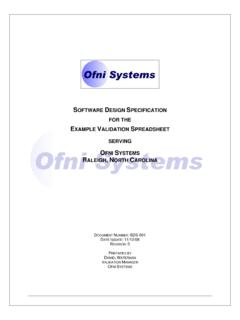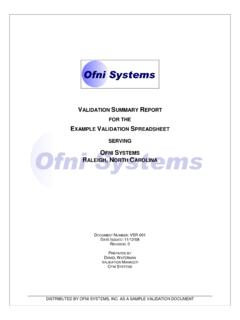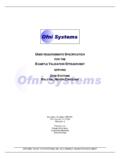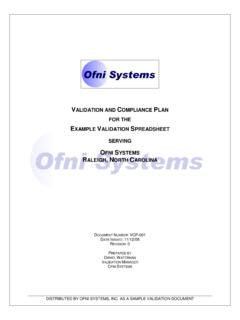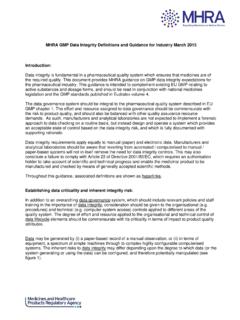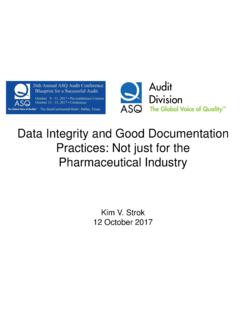Transcription of Data Integrity Article - Ofni Systems
1 Review of Good data Integrity Principles Covering the recent emphasis on data Integrity by regulatory agencies, currently existing data Integrity guidelines, and who data Integrity guidelines most affect 808 Salem Woods Drive Suite 103 Raleigh, NC 27615 (919) 844-2494 Review of Good data Integrity Principles Page 2 of 11 Table of Contents Introduction and Sources of Information .. 3 What is data Integrity ? .. 3 data Integrity 3 Principles of ALCOA .. 3 ALCOA Defined .. 3 Meeting ALCOA data 3 data Integrity guidance Documents .. 4 FDA Draft guidance on data Integrity .. 5 FDA guidance on Electronic Source data in Clinical Investigations .. 5 WHO guidance on Good data and Record Management 6 MHRA GxP data Integrity Definitions and guidance for Industry.
2 6 data Integrity Training and Auditing .. 6 data Alteration Controls .. 6 Assigning Roles and Providing Appropriate Training .. 7 data Integrity Training 7 Analytical Laboratories .. 7 Medical Devices .. 8 Clinical Investigations .. 9 Electronic Source data Overview .. 9 eCRF data Capturing .. 9 Good Manufacturing Practices .. 9 Audit Trail Summary Tools .. 10 References .. 11 Review of Good data Integrity Principles Page 3 of 11 Introduction and Sources of Information What is data Integrity ? data Integrity is the idea of maintaining and ensuring the accuracy and consistency of data over its lifecycle. This includes good data management practices, such as preventing data from being altered each time it is copied or moved. data Integrity applies to both paper records and electronic records.
3 Processes and procedures are put in place for companies to maintain data Integrity during normal operation [1]. data Integrity Importance data in its final state is the driving force behind industry decision making. Raw data must be changed and processed to reach a more usable format. data Integrity ensures that this data is attributable, legible, contemporaneous, original, and accurate (ALCOA). data can easily become compromised if proper measures are not taken to ensure data safety. Errors with data Integrity commonly rise from human error, noncompliant operating procedures, data transfers, software defects, compromised hardware, and physical compromise to devices. Maintaining data Integrity is a necessary part of the industry s responsibility to ensure the safety, effectiveness, and quality of their products [1].
4 Principles of ALCOA In recent years, regulators have found that many organizations are falling short when it comes to maintaining adequate data Integrity within computerized Systems . Due to the increasing number of observations related to data Integrity made during inspections, a WHO committee has decided to outline a new guidance meant to consolidate and improve upon existing principles ensuring data Integrity from current good practices and guidance documents [2]. ALCOA Defined Attributable: Every piece of data entered into the record must be capable of being traced back to the time it was taken and to the individual who entered it. Legible: All data (including metadata) must be traceable, permanent, readable, and understandable by anyone reviewing the record. Contemporaneous: data that are summarily entered into the record at the time they are generated.
5 Original: Source data that is the record medium in which the data was first recorded. An original data record should include the first data entered and all successive data entries required to fully detail the scope of the project. Accurate: Correct, truthful, complete, valid, and reliable data with controls in place to assure the accuracy of data should be implemented on a risk-based structure [2]. Meeting ALCOA data Expectations Attributable: Requires the use of secure and unique user logons and electronic signatures. Using generic login IDs or sharing credentials must always be avoided. Unique user logons allow for individuals to be linked to the creation, modification, or deletion of data within the record. For a signature to be legally-binding there should be a secure link between the person signing and the resulting signature.
6 The use of Review of Good data Integrity Principles Page 4 of 11 digital images of hand written signatures is not considered a secure or credible method for electronically signing documents [2]. Legible: In order for an electronic record to be considered legible, traceable, and permanent it must utilize controls such as following SOPs and designing a system that promotes saving electronic data in concurrence with the execution of the activity. This is best done by prohibiting the creation of data in temporary memory as well as immediately committing data to a permanent memory before moving on. Secure time stamped audit trails are to be used to record operator actions. The system configuration must limit security rights allowing users to turn off the audit trail or overwrite data .
7 These administrative rights should be reserved (whenever possible) for individuals who are independent of those responsible for the content of the electronic records. Improperly overwriting data or manipulating the audit trail impairs the legibility of the data by obscuring the original value of the record [2]. Contemporaneous: Utilizes the controls of writing SOPs and maintaining settings that immediately commit data to a permanent memory. In order for the data to be considered contemporaneous, the record must also have a secure time stamp system that cannot be altered by users. Time and date stamps need to be synchronized across all Systems involved in the GxP activity. data is not considered contemporaneous when recorded on an unofficial document and then later entered into the official electronic record [2].
8 Original: Original electronic records (or certified true copies) must be reviewed and approved with standardized procedures. These procedures should describe the review method itself as well as any changes made to the information in the original records, including changes documented in audit trails or any other relevant metadata. Written procedures should define the frequency, roles and responsibilities, and approach to the review of metadata. Once reviewed, electronic data sets should be electronically signed to document their approval. Controls should also be put in place to guarantee the retention of original electronic documents as best as possible. The original record should be routinely backed up and stored separately in a safe location in case the original record is lost.
9 Secure storage areas should have a designated electronic archivist who is independent of the GxP operation. Tests ought to be carried out at times in order to verify that the copy can be retrieved and utilized from secure storage areas [2]. Accurate: data should be maintained through a quality management system that is risk-based. Routine calibration and equipment maintenance needs to be performed. Computer Systems that generate, maintain, distribute, or archive electronic records should be validated. Entry of critical data such as high priority formulas for spreadsheets should be verified by two authorized individuals. Once verified, critical data fields must be locked to prevent modification by any unauthorized individuals [2]. data Integrity guidance Documents As the pharmaceutical and medical device industries continue to grow and outsource work, an increasing number of guidance documents are released to regulate and supervise production and Review of Good data Integrity Principles Page 5 of 11 development.
10 In July 2012, the Food and Drug Administration (FDA) Safety and Innovation Act was signed into law. FDASIA increases the FDA s authority to have better control over the increasing global drug supply chain. Nearly 80 percent of active ingredients for pharmaceuticals comes from sources overseas [3]. Due to this increasing market, the foreign drug quality inspections nearly doubled from 2010 to 2015. The FDA responded with guidance intended to improve data Integrity in Clinical Investigations as well as draft guidance to address more recent questions and concerns on data Integrity for GMP facilities. The World Health Organization (WHO) released Annex 5 guidance on Good data and Record Management Practices, a guidance to help bridge the gaps in current data Integrity guidance .
